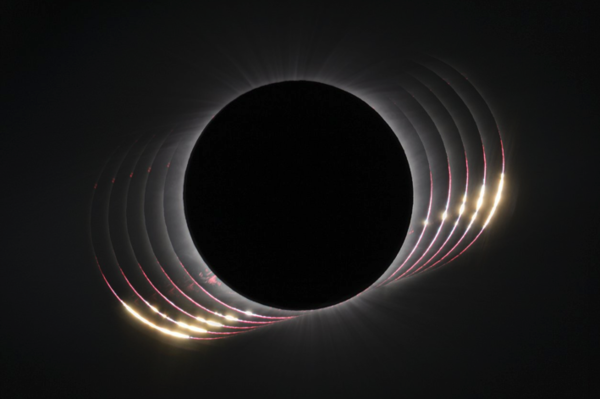Introducing SunSketcher
From RHESSI Wiki
(added Fivian et al.) |
|||
| Line 21: | Line 21: | ||
We discussed the history of this question in an | We discussed the history of this question in an | ||
[https://sprg.ssl.berkeley.edu/~tohban/wiki/index.php/History_of_Solar_Oblateness earlier Nugget]. | [https://sprg.ssl.berkeley.edu/~tohban/wiki/index.php/History_of_Solar_Oblateness earlier Nugget]. | ||
| + | This is indeed a RHESSI topic, since Ref. [2] took advantage of RHESSI's steady rotation to obtain | ||
| + | the currently best measurement of the solar oblateness from its solar aspect sensors. | ||
The answer is of course "very round", but there are several mechanisms that will distort | The answer is of course "very round", but there are several mechanisms that will distort | ||
the solar surface. | the solar surface. | ||
| - | Since solar gravity is so strong - about | + | Since solar gravity is so strong - about 28x the Earth's - we don't expect major |
distortions. | distortions. | ||
Solar rotation could make the sun somewhat | Solar rotation could make the sun somewhat | ||
| Line 91: | Line 93: | ||
[1] [http://adsabs.harvard.edu/abs/1974ApJS...27..131D "The Oblateness of the Sun"] | [1] [http://adsabs.harvard.edu/abs/1974ApJS...27..131D "The Oblateness of the Sun"] | ||
| + | |||
| + | [2] [http://adsabs.harvard.edu/abs/2008Sci...322..560F "A Large Excess in Apparent Solar Oblateness Due to Surface Magnetism"] | ||
Revision as of 13:20, 17 September 2023
| Nugget | |
|---|---|
| Number: | 455 |
| 1st Author: | Hugh HUDSON |
| 2nd Author: | Gordon EMSLIE |
| Published: | September 11, 2023 |
| Next Nugget: | TBD |
| Previous Nugget: | TeV Gamma rays from the Quiescent Sun |
| List all | |
Contents |
Background
Solar eclipses fascinate us with their drama and beauty, and their scientific credentials go way back before the word "scientific" actually existed. In this modern space age, actual observations from the surface of the Earth no longer have so much cutting-edge research impact, but in this Nugget we introduce the SunSketcher project. SunSketcher takes advantage of modern technology and crowdsourced help to tackle a basic astronomical question: How round is the Sun? We discussed the history of this question in an earlier Nugget. This is indeed a RHESSI topic, since Ref. [2] took advantage of RHESSI's steady rotation to obtain the currently best measurement of the solar oblateness from its solar aspect sensors.
The answer is of course "very round", but there are several mechanisms that will distort the solar surface. Since solar gravity is so strong - about 28x the Earth's - we don't expect major distortions. Solar rotation could make the sun somewhat oblate but how much would depend upon the interior flows. There is no guarantee that a big ball of incandescent magnetized gas would want to rotate in any uniform way. The implications of any deviations of the solar surface from its apparently immaculate sphere are profound, touching not just on the complicated internal structure of our nearest star, but also on relativity (Ref. [1]).
How SunSketcher works
The project makes use of smartphones (huge numbers of them, if possible) each one precisely tagged in space and in time by GPS. Combining this with the precise altimetry of the Moon, recorded in the LOLA database we can watch Baily's beads blink on and off during an eclipse, and do this so redundantly that we can get a full map of the circumference of the Sun, and even watch it change with time. Figure 1 shows a wonderful set of images, obtained at ESO La Silla in the 2019 total eclipse by P. Horálek.
The tiniest last and first Baily's Beads pinpoint a lunar valley, and from different perspectives within and along the track of the eclipse we can thus measure the whole arc of the solar disk.
SunSketcher provides a free smartphone app. In addition to providing full information about eclipses and safety, the app will have a single button-push to enable it obtain a sequence of observations, and then automatically upload them to a repository. The observer just has to prop the phone up to face the Sun squarely at about the proper angle (64 degrees at Dallas, for example, and 49 degrees for Cleveland).
We are "beta-testing" the Sunsketcher app at the forthcoming annular eclipse in October 2023.
Data Analysis
In a sense this is unknown territory, since nobody has attempted previously to make observations with this degree of precision. One way to analyze the data will be to create time-series of brightness at a given azimuth on the limb. With thousands of image sequences, the data will allow a very overdetermined epoch of the first or last moment of a Bead's visibility.
We expect that a more comprehensive analysis will involve a massive forward-method modeling, whereby we create a model Sun that is parametrized to describe oblateness, and may have other features (such as sunspot groups) that would create signal as well. Then there would then be a model-fitting procedure to evaluate those parameters. But since this is exploratory, we are open for ideas and will certainly make our data available for public access.
References
[1] "The Oblateness of the Sun"
[2] "A Large Excess in Apparent Solar Oblateness Due to Surface Magnetism"
| RHESSI Nugget Date | 11 September 2023 + |
| RHESSI Nugget First Author | Hugh HUDSON + |
| RHESSI Nugget Index | 455 + |
| RHESSI Nugget Second Author | Gordon EMSLIE + |
